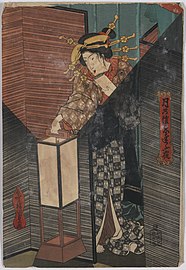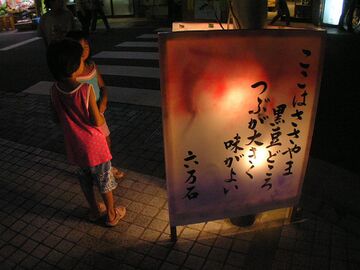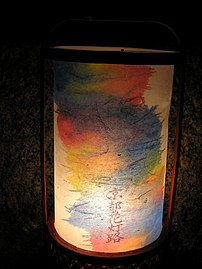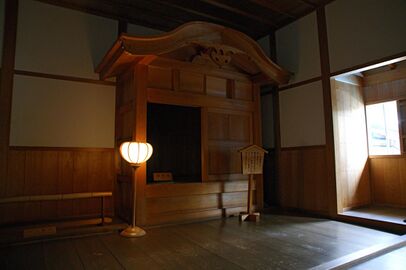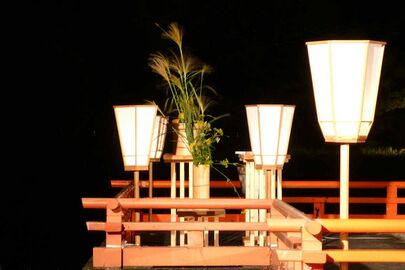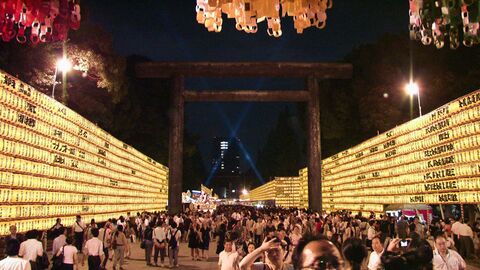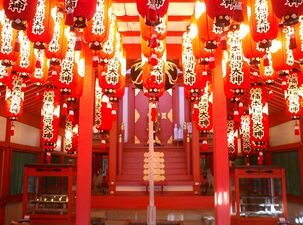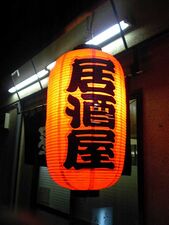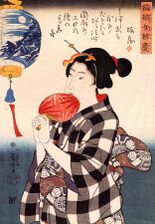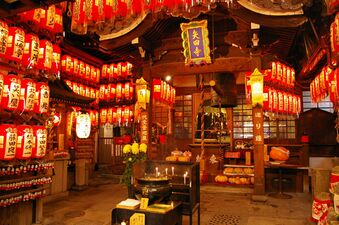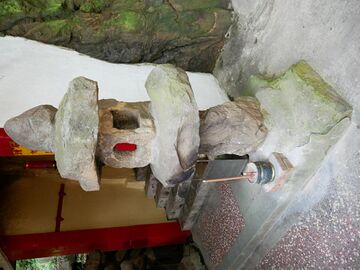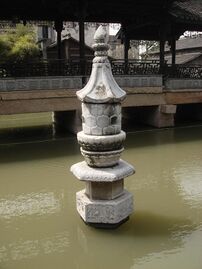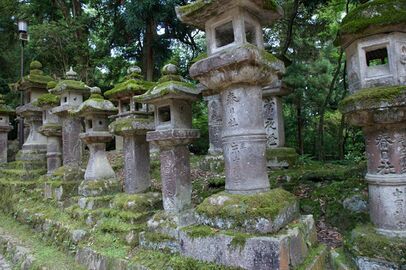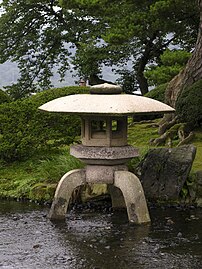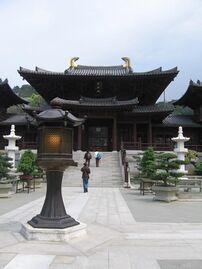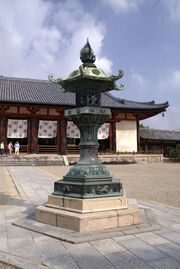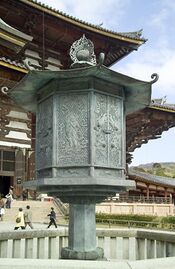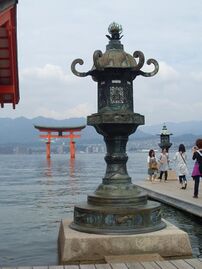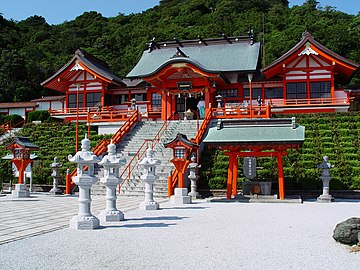Earth:Traditional lighting equipment of Japan
The traditional lighting equipment of Japan includes the andon (行灯), the bonbori (雪洞), the chōchin (提灯), and the tōrō (灯篭).
Andon
The andon is a lamp consisting of paper stretched over a frame of bamboo, wood or metal.[1] The paper protected the flame from the wind. Burning oil in a stone, metal, or ceramic holder, with a wick of cotton or pith, provided the light. They were usually open on the top and bottom, with one side that could be lifted to provide access.[2] Rapeseed oil was popular. Candles were also used, but their higher price made them less popular. A lower-priced alternative was sardine oil.
The andon became popular in the Edo period (1603–1867).[1] Early on, the andon was handheld; it could also be placed on a stand or hung on a wall.[3] The okiandon was most common indoors. Many had a vertical box shape with an inner stand for the light. Some had a drawer on the bottom to facilitate refilling and lighting. A handle on top made it portable. A variety was the Enshū andon. One explanation attributes it to Kobori Enshu, who lived in the late Azuchi-Momoyama period and early Edo period. Tubular in shape, it had an opening instead of a drawer.[4] Another variety was the Ariake andon, a bedside lamp. The kakeandon under the eaves of a shop, often bearing the name of the merchant, was a common sight in the towns.
The expression hiru andon, or "daytime lamp," meant someone or something that seemed to serve no purpose.[5] In dramatizations of the story of the forty-seven ronin, Oishi Yoshio is often given this description.
Bonbori
The bonbori (
Bonbori lining the Sandō at a Bonbori Festival
Chōchin
A relative of the Chinese paper lantern, the chōchin has a frame of split bamboo wound in a spiral. Paper or silk protect the flame from wind. The spiral structure permits it to be collapsed into the basket at the bottom.[8] The chōchin is used outdoors, either carried or hung outside the house.[1] In present-day Japan, plastic chōchin with electric bulbs are produced as novelties, souvenirs, and for matsuri and events.[9] The earliest record of a chōchin dates to 1085,[8] and one appears in a 1536 illustration.
The akachōchin, or red lantern, marks an izakaya.[10] In Japanese folklore, the chochin appears as a yōkai, the chōchin-obake.[11]
Gifu is known for its Gifu lanterns, a kind of chōchin made from mino washi.[12]
Tōrō
Originally used in the broad sense to mean any lantern, the term tōrō came to refer to a lamp of stone, bronze, iron, wood, or another heavy material. These illuminate the grounds of Buddhist temples, Shinto shrines, Japanese gardens, and other places that include tradition in their decor.[1] The earlier use of oil and candles has in the modern day been replaced by electric bulbs.
Stone tōrō
Bronze tōrō
Wooden tōrō
See also
- Tōrō nagashi
- Physalis alkekengi, the Japanese lantern plant
References
- ↑ Jump up to: 1.0 1.1 1.2 1.3 "tourou 灯籠". https://www.aisf.or.jp/~jaanus/deta/t/tourou.htm. Retrieved 18 June 2022.
- ↑ Morse, Edward S. (1885). Japanese Homes and their Surroundings. Charles E. Tuttle Company. p. 221-222. ISBN 0-8048-0998-4. https://www.gutenberg.org/files/52868/52868-h/52868-h.html.
- ↑ Yagi, Koji (1992). A Japanese Touch for Your Home. Kodansha International. p. 71. ISBN 9784770016621. https://books.google.com/books?id=YCK8c3E7LK4C&dq=Andon+Koji+Yagi&pg=PA71.
- ↑ Kerr, Alex (5 July 2018). Another Kyoto. Penguin Books. ISBN 9780141988344. https://books.google.com/books?id=ml5PDwAAQBAJ&dq=%22Ensh%C5%AB+andon%22&pg=PT56.
- ↑ De Mente, Boyé Lafayette. Japan's Cultural Code Words. Tuttle Publishing. p. 96-97.
- ↑ Iwanami Kōjien (広辞苑) Japanese dictionary, 6th Edition (2008), DVD version
- ↑ "Bonbori Matsuri". http://www.buddhist-artwork.com/bonbori-festival/html/bonbori.html. Retrieved 8 August 2010.
- ↑ Jump up to: 8.0 8.1 Joya, Mock (2017). Japan and Things Japanese. Routledge. p. 8, 36-37.
- ↑ "What are Chochin lanterns". Japan Talk. https://www.japan-talk.com/jt/new/chochin.
- ↑ Bunting, Chris (2014). Drinking Japan: A Guide to Japan's Best Drinks and Drinking Establishments. Tuttle Publishing. p. 20. ISBN 978-1-4629-0627-7. https://books.google.com/books?id=3ZUdBAAAQBAJ&pg=PA20.
- ↑ Bush, Lawrence (2001). Asian horror encyclopedia: Asian horror culture in literature, manga and folklore. Writers Club Press.. p. 109.
- ↑ Gifu Paper Lanterns. Japan National Tourist Organization. Accessed April 30, 2008.
External links
- Japanese Gardening, Lanterns. Accessed on February 2, 2010
 |

